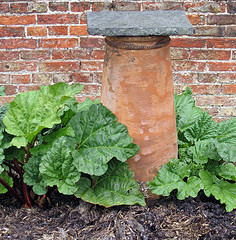Forcing-Rhubarb To Grow
Rhubarb Production Unseasonal
Try forcing-rhubarb to grow indoors to provide fresh off-season-rhubarb. You can encourage rhubarb to grow in your basement or garage over the winter months. You don't actually have to wait until Spring.
After the outdoor harvest and before the first winter freeze, select a few older plants and dig them up. Make sure they are still well blanketed in their original soil.
They can now be placed into large pots or half barrels and covered with straw. The straw will keep them moist while they go through the first freeze outside.
At this point, bring them inside to your basement or garage or where the temperature is at least fifty degrees.
To transplant-rhubarb indoors, you must follow a few rules. There must be good ventilation around the pots so that mould does not grow. The light must be kept out. Yes,...keep the light out! This prevents chlorophyll from developing, and that means the leaves won't grow very fast. In turn, this makes the stalks juicier.
The stalks should be ready to harvest in approximately one month. Don't abandon your pots just yet. These plants will continue to produce more yummy stalks for another 4 or 5 weeks or more.
Once the temperatures warm outdoors, transplant this root again to your rhubarb garden. And, have patience. It may take awhile for this plant to produce again, but in time it will.
Forcing rhubarb outside can be done as well in order to speed up the entire process. Just place large pots over the crowns of your rhubarb and insulate with straw or manure.
Have you ever heard of Champagne Rhubarb? It is considered
a delicacy and the concept originates from these forcing pots.
Find Out About Champagne Rhubarb
Did you know that wool waste contributes to the success of rhubarb growing?
According to one farmer, wool waste helps fertilize the ground.
This product has been used for quite a few years. The wool is spread and reduces the need for any type of chemical or manure. Wool waste stirs up the soil and microbes from the dirt break down the wool. This produces nitrogen and it goes into the soil.
Partnerships for the wool waste or "shoddy" as it is referred to as well, have been formed between farmers and owners of textile companies. The waste is hard to get, as wool is reported to be a declining industry in Yorkshire.
Forcing-Rhubarb Photo Courtesy of Jonathan Ratnage
Leave Forcing-Rhubarb,
Return To Home Page












New! Comments
Have your say about this topic. Leave me a comment in the box below.